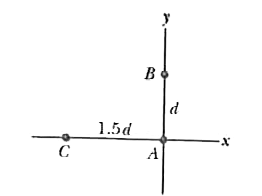Two dimensions. Three point particles are fixed in place in an xy plane. Particle A has mass , particle B has mass and particle C has mass . A fourth particle D, with mass is to be placed near the other three particles. In order for the net force on particle A due to the other three particles to be zero, where should particle D be located? Give (a) the distance from A in terms of d and (b) the angle relative to the positive direction of the x axis?

(a) (b)
Topper's Solved these Questions
- GRAVITATIONBOOK - RESNICK AND HALLIDAYCHAPTER - GRAVITATIONEXERCISE - PRACTICE QUESTIONS (SINGLE CORRECT CHOICE TYPE)
16 Videos
- GRAVITATIONBOOK - RESNICK AND HALLIDAYCHAPTER - GRAVITATIONEXERCISE - PRACTICE QUESTIONS (MORE THAN ONE CORRECT CHOICE TYPE)
7 Videos
- GRAVITATIONBOOK - RESNICK AND HALLIDAYCHAPTER - GRAVITATIONEXERCISE - CHECKPOINT
5 Videos
- GEOMETRICAL OPTICS : REFRACTIONBOOK - RESNICK AND HALLIDAYCHAPTER - GEOMETRICAL OPTICS : REFRACTIONEXERCISE - Practice questions(Integers)
4 Videos
- HEAT-MEASUREMENT AND TRANSFERBOOK - RESNICK AND HALLIDAYCHAPTER - HEAT-MEASUREMENT AND TRANSFEREXERCISE - PRACTICE QUESTIONS( INTEGER TYPE)
5 Videos
Similar Questions
Three deminsions. Three point particles are fixed in place in a xyz coordinate system. Particle A, at the origin, has mass mA. Particle B, at xyz coordinates (2.00d,1.00d. 200), has mass 2.00mA, and particle C, at coordinates (-1.00d,2.00d,-3.00d), has mass 3.00mA. A fourth particle D,with mass 4.00mA,is to be placed near the other particles. In terms of distance d, at what (a)x, (b)y, and (c)z coordinate should D be placed so that the net gravitational force on A from B, C, and D is zero ?
View SolutionA semicircular wire has a length L and mass M. A particle of mass m is placed at the center of the circle. Find the gravitational attraction on the particle due to the wire.
View Solution
Knowledge Check
Three particles each of mass m are palced at the corners of an equilateral triangle of side b. The gravitational potential energy of the system of particle is
A−3Gm22bB−Gm22bC−3Gm2bD−Gm2bIn the figure given below, two particles of masses m and 2m are fixed in place on an axis. Where on the axis can a third particle of mass 3m be placed (other than at infinity) so that the gravitational force on it from the first two particles is zero?
 ABetween m and 2 mBLeft of mCRight of 2mDThe net gravitational force on 3m never be zero
ABetween m and 2 mBLeft of mCRight of 2mDThe net gravitational force on 3m never be zero
A semicircular wire has a length L and mass M. A particle of mass m is placed at the centre of the circle. Find the gravitational attraction on the particle due to the wire.
View SolutionFour particles each of mass 'm' are placed at the four vertices of a square 'a' .Find net force on any one the particle.
View SolutionFour particles each of mass 'm' are placed at the four vertices of a square 'a' .Find net force on any one the particle.
View SolutionA particle of mass m1, hits another particle in rest of mass m2, obliquely, If both the particles after elastic collision moves perpendicular to each other then m1m2 is
View SolutionA particle of mass m1, hits another particle in rest of mass m2, obliquely, If both the particles after elastic collision moves perpendicular to each other then m1m2 is
View SolutionA particle of mass m, hits another particle in rest of mass m2, obliquely If both the particles after elastic collision moves perpendicular to each other then m1m2
View Solution
